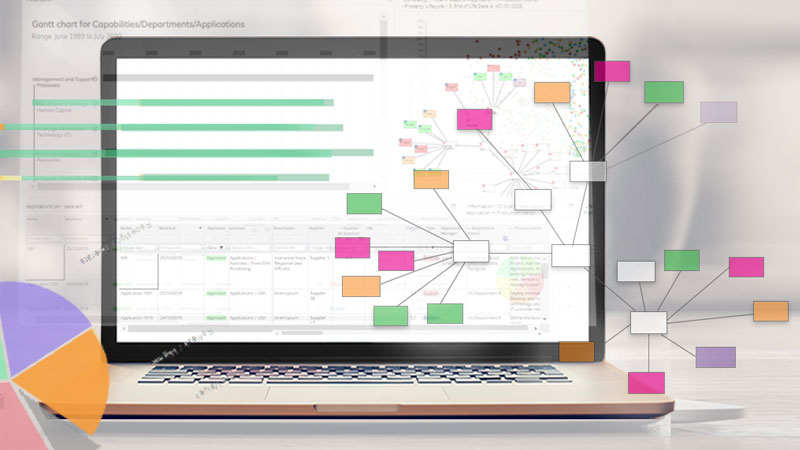How is the role of enterprise architects and digital managers changing? Entering the 2020s, there is a bigger demand than ever for risk-management, scenario planning and impact analysis.
Behind the scenes, ensuring good data stewardship by keeping data sprawl and complexity in hand is more important than ever.
Enterprise architecture expert, Avolution’s Dr Tim O’Neill says: “Before embarking on a project or strategy, architects need to ask themselves: what do I need to know to de-risk this, and gear it for a high likelihood of success? By sketching out scenarios, risks and snares can often be anticipated and prevented.”
Digital strategy and architecture professionals can now also call on new techniques including enhanced machine learning features and graph analytics to increase data fidelity and calculate business-outcome focussed KPIs.
“Machine learning will never replace enterprise architects or digital strategy managers,” said O’Neill. “But it can help clear a key hurdle by allowing a partial dataset with missing values to become usable.”
“Architects and data scientists can increase speed and productivity by reviewing and accepting machine-learning-generated values, producing a more complete dataset quickly.
“Further verification of the synthetic data can continue in the background, confirming accuracy or increasing confidence intervals. Architects can get on with modeling, running analytics and planning.”
Knowledge graphs are really coming of age and looking towards the 2020s Gartner has predicted that graph analytics are also maturing.
O’Neill said: “Like any popular technology, the proof is in how easily users can execute with it. ABACUS’ no-code analytics engine allows users to assemble calculations from data held in its graph database. Both technical and business users can tailor analytics and metrics such as cost, performance and other KPIs, and then use these to map out scenario options.
“It’s also important to be able to distil these forecasts down to simple visualization. A new Graph View visual in our ABACUS 7 release offers real-time interaction with the graph database. Users can explore connections, relationships, and structure and function of architectures visually.”
ABACUS 7 will also include new interactive Gantt charts for tracking timelines of projects and technology. These update automatically as users change architecture data. Architects can also draw attention to specific data by saving filters in dashboard URLs, then provide these pre-filtered dashboards to users.
Over one hundred additional new features and updates have also been added since ABACUS 6.0. Over the last year, fresh features have been rolled out to users regularly. These include:
- Pixel Perfect Visio Shape Import
- UI improvements to browser-based lists and dashboards: “Freeze” columns for scrolling, filter & query updates, dashboard quick copy
- Enhanced chat and email collaboration, open a conversation from a dashboard, in MS Teams, Skype or email
- Conditional filter blocks in the No-Code Algorithm Composer
- “Snapshot” audit trails of repository in-browser
In October, Avolution and ABACUS were recognized by Gartner as a Leader in its 2019 Magic Quadrant for Enterprise Architecture Tools*, published 22 October 2019.
ABACUS is available as either a cloud-based web-app or for on-premise deployment.
Download your free 30 day trial of ABACUS today
Try ABACUSPress Enquiries:
Communications Manager, Avolution
E: [email protected]
About ABACUS
ABACUS is used by companies worldwide to manage Enterprise Architecture, IT and business strategy and digital transformation. ABACUS users deliver insights and value quickly:
- Import data in minutes from SharePoint, Excel, Visio, Google Sheets, Technopedia, ServiceNow and other sources.
- Choose an off-the-shelf framework or metamodel, or configure an enterprise specific metamodel.
- Create current and future state architectures and roadmaps. Analyze architectures using algorithms for metrics such as TCO, Performance, Availability and Agility.
- Report with rich visuals and dashboards including Gannt charts, heat maps, treemaps, lifecycles, capability spaces and trade-off diagrams.
ABACUS supports Enterprise Architecture (EA), Application Portfolio Management (APM), Business Process Management (BPM), Solution Architecture (SA), IT Service Management (ITSM), Innovation & Change Management, Cybersecurity, Cloud Transformation and Data Privacy Use Cases and Governance, Risk & Compliance (GRC). It is available on-premise or as a browser-based SaaS tool.
*Gartner “Magic Quadrant for Enterprise Architecture Tools” by Marty Resnick and James McGovern, 22 October 2019, https://www.gartner.com/doc/3970555 (Gartner subscription required)
Gartner Disclaimer
Gartner does not endorse any vendor, product or service depicted in its research publications, and does not advise technology users to select only those vendors with the highest ratings or other designation. Gartner research publications consist of the opinions of Gartner’s research organization and should not be construed as statements of fact. Gartner disclaims all warranties, expressed or implied, with respect to this research, including any warranties of merchantability or fitness for a particular purpose.


